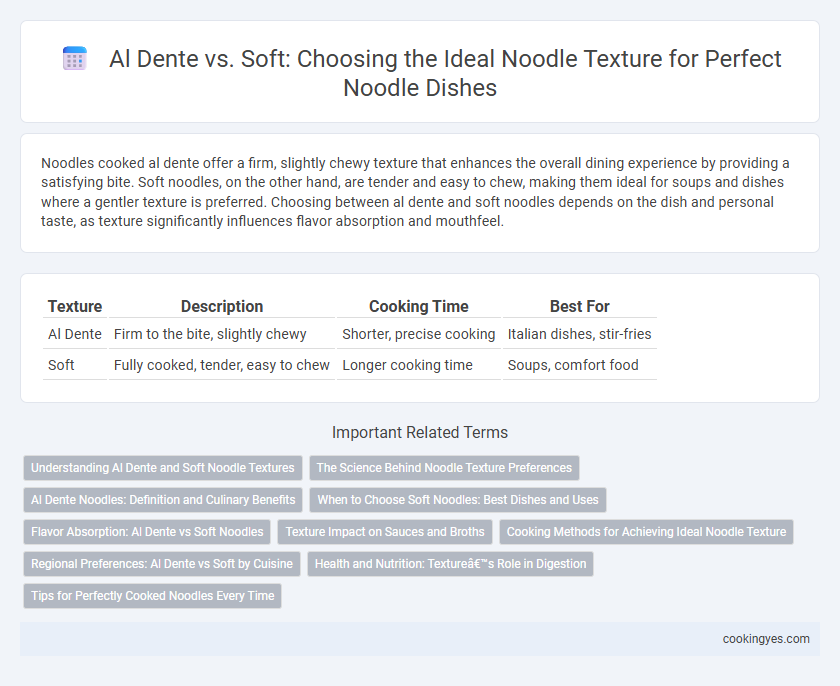Noodles cooked al dente offer a firm, slightly chewy texture that enhances the overall dining experience by providing a satisfying bite. Soft noodles, on the other hand, are tender and easy to chew, making them ideal for soups and dishes where a gentler texture is preferred. Choosing between al dente and soft noodles depends on the dish and personal taste, as texture significantly influences flavor absorption and mouthfeel.
Table of Comparison
| Texture | Description | Cooking Time | Best For |
|---|---|---|---|
| Al Dente | Firm to the bite, slightly chewy | Shorter, precise cooking | Italian dishes, stir-fries |
| Soft | Fully cooked, tender, easy to chew | Longer cooking time | Soups, comfort food |
Understanding Al Dente and Soft Noodle Textures
Al dente noodles have a firm texture with a slight resistance when bitten, preserving the noodle's structure and enhancing flavor absorption. Soft noodles, by contrast, are cooked longer, resulting in a tender and easily chewable consistency favored in soups and mild-flavored dishes. Understanding these textures helps chefs and home cooks optimize cooking times for diverse culinary applications and personal preferences.
The Science Behind Noodle Texture Preferences
Noodle texture preferences, such as al dente versus soft, are influenced by starch gelatinization and protein network formation during cooking. Al dente noodles retain a firmer structure due to incomplete starch swelling and a stronger gluten matrix, which slows digestion and provides a satisfying chew. Softer noodles result from prolonged cooking, leading to full starch gelatinization and weakened gluten, impacting both texture and glycemic response.
Al Dente Noodles: Definition and Culinary Benefits
Al dente noodles retain a firm, slightly chewy texture that enhances both mouthfeel and flavor absorption, making them a preferred choice in many Italian dishes. Cooking noodles al dente preserves their structural integrity, preventing overcooking and mushiness while providing an optimal balance between tenderness and bite. This texture not only improves the dining experience but also aids in slower digestion, contributing to sustained energy release.
When to Choose Soft Noodles: Best Dishes and Uses
Soft noodles are ideal for soups like ramen and pho, where the broth's flavors blend seamlessly with the tender noodle texture. They work best in casseroles and stir-fries that require noodles to absorb sauces and remain pliable rather than firm. Choosing soft noodles enhances dishes that benefit from a comforting, easily chewable consistency, complementing rich or savory ingredients.
Flavor Absorption: Al Dente vs Soft Noodles
Al dente noodles maintain a firmer texture that better holds sauces on the surface, leading to a more pronounced and concentrated flavor in each bite. Soft noodles absorb liquids more thoroughly, resulting in a milder taste as the sauce is diluted within the noodle structure. Choosing between al dente and soft textures influences the intensity and distribution of flavor in noodle dishes, affecting the overall culinary experience.
Texture Impact on Sauces and Broths
Al dente noodles maintain a firm texture that allows sauces and broths to cling effectively without becoming mushy, enhancing flavor absorption and providing a satisfying bite. Soft noodles, while tender, tend to absorb more liquid and can dilute the sauce, leading to a less concentrated flavor profile. The choice between al dente and soft texture significantly influences the overall mouthfeel and taste intensity in dishes featuring various noodle sauces and broths.
Cooking Methods for Achieving Ideal Noodle Texture
Cooking methods for achieving ideal noodle texture vary significantly between al dente and soft preferences. To attain al dente noodles, boil them in rapidly boiling water for a shorter duration, typically 1-2 minutes less than package instructions, and immediately rinse in cold water to halt cooking. For soft noodles, extend boiling time and avoid rinsing, allowing residual heat to continue softening the noodles for a tender, chewy bite.
Regional Preferences: Al Dente vs Soft by Cuisine
Italian cuisine predominantly favors al dente noodles, prized for their firm texture that enhances pasta dishes like spaghetti and penne, preserving the pasta's shape and bite. In contrast, East Asian cuisines, such as Japanese and Chinese, often prefer softer noodles, which better absorb broths and sauces in dishes like ramen and lo mein, creating a tender mouthfeel. Southeast Asian noodle dishes also tend to favor softer textures, complementing stir-fried or soup-based recipes where flexibility and flavor absorption are key factors.
Health and Nutrition: Texture’s Role in Digestion
Al dente noodles retain more resistant starch, which aids in better digestion and helps regulate blood sugar levels, making them a healthier choice compared to soft-cooked noodles. Softer noodles, while easier to chew, tend to have a higher glycemic index due to increased starch gelatinization, potentially leading to quicker glucose absorption. Choosing al dente texture supports improved gut health by promoting slower digestion and sustained energy release.
Tips for Perfectly Cooked Noodles Every Time
Achieving the perfect noodle texture requires precise timing and attention to water temperature; noodles cooked Al dente typically take 7-9 minutes in boiling water, retaining a firm bite, while softer noodles may need 10-12 minutes or a longer soak in hot water. To prevent overcooking, immediately drain noodles and rinse briefly with cold water to halt the cooking process, especially for pasta salads or stir-fries. Using ample boiling water and stirring occasionally helps avoid clumping and ensures even cooking, resulting in consistently delicious, perfectly textured noodles.
Al dente vs Soft for noodle texture Infographic

 cookingyes.com
cookingyes.com